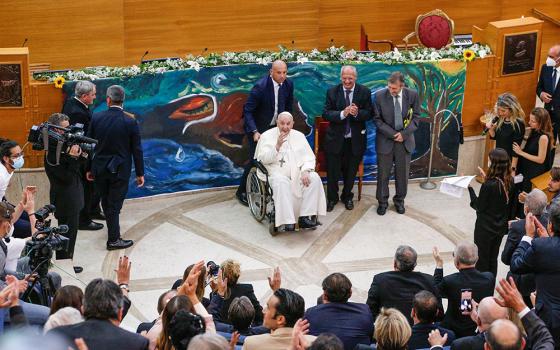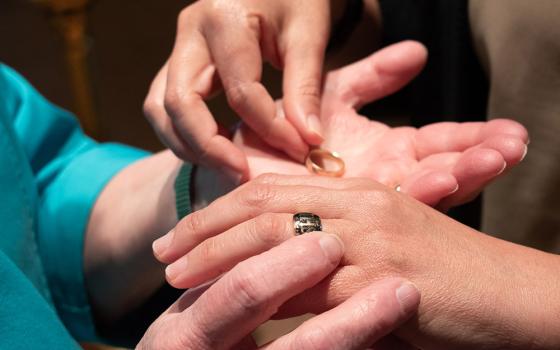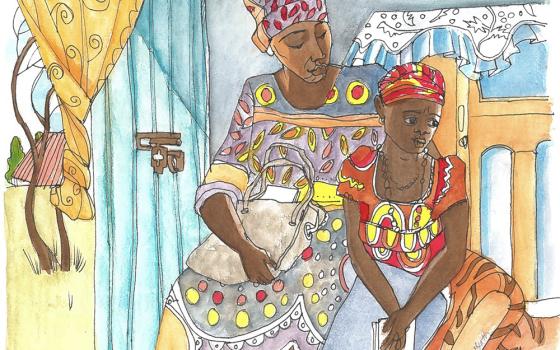
Behind the grille at the 130-year-old St. Joseph of Guadalupe Monastery, Discalced Carmelite Sister Dora Patricia del Jesús Resucitado explains a bit about its history Aug. 27 near the grounds of the Our Lady of Guadalupe Basilica in Mexico City. (GSR photo/Rhina Guidos)
It's always strange to knock on the door of a stranger. And that was the case knocking on the door of the St. Joseph of Guadalupe Monastery at Mexico City's Tepeyac Hill, a community that is home to eight Discalced Carmelite sisters who live in one of the most revered places by Catholics in the Americas.
An understated plaque above the monastery door repeats the oft-told story that says near that spot "at dawn on Dec. 9, 1531, the mother of God appeared for the first time to Juan Diego," referring to the Indigenous Mexican saint, said to have been witness to 16th-century apparitions of Mary in the surroundings of Tepeyac Hill.
Paintings inside the church adjacent to the Carmelites' monastery depict how she asked him to tell the bishop to build her a shrine on that hill and when the prelate asked for proof, she sent Juan Diego nearby to pick roses — in winter. When Juan Diego delivered them to the bishop, tradition says that the image — now globally recognized as Our Lady of Guadalupe — was imprinted on the cloak in which he had carried the flowers.
Where the sisters now live, the plaque says, "on the morning of Dec. 12, Juan Diego picked the roses of the miracle." From that spot, the Carmelites now have a bird's-eye-view of the Basilica of Our Lady of Guadalupe below. While the shrine is the main attraction, many pilgrims, including some who are physically compromised, make the taxing climb up to nearby Tepeyac Hill.

A plaque above the door of the St. Joseph of Guadalupe Monastery near the grounds of Mexico City's Basilica of Our Lady of Guadalupe says near that spot "at dawn on Dec. 9, 1531, the mother of God appeared for the first time to Juan Diego," referring to the Indigenous Mexican saint, said to have been witness to 16th-century apparitions of Mary in the surroundings of Tepeyac Hill. (GSR photo/Rhina Guidos)
Even as large crowds gather outside, the sisters maintain a silent, contemplative space in the monastery that celebrated 130 years in May, though few have ever noticed it.
The Mexican news site Milenio, in a 2021 article, called it the Basilica of Our Lady of Guadalupe's "secret convent." It noted that prior to the pandemic, there was little signage letting people know it was there and it blends so well into the baroque façade of the church, known as the Capilla del Cerrito (the chapel on the hill), that it's hard to tell there's a separate structure.
These days, however, there's a banner outside with photos of the sisters, and a question: "Do you feel called to religious life?" It lists a phone number, and to the curious, the "ring the bell" next to the sign is an invitation.
I rang the bell.
I don't quite remember what I said other than I was a reporter and a visitor who wanted to know about the sisters. After what felt like a long moment with no response, Carmelite Sister Dora Patricia del Jesus Resucitado buzzed me in.
Because of the silence, it's hard to tell as you're going up the spiral steps that you're near one of the most visited sites in Catholicism. Last year, the Mexican government estimated that more than 12.5 million people visited the shrine and its environs in 2022 — a record-breaking figure expected to climb this year.

A visitor looks at the St. Joseph of Guadalupe Monastery, the brown part to the right of a chapel at the top of Tepeyac Hill, near the Basilica of Our Lady of Guadalupe in Mexico City Aug. 27. (GSR photo/Rhina Guidos)
Sister Dora Patricia told Global Sisters Report in August that even though the monastery flies under the radar, there are pilgrims who notice the sign and stop in.
"They continually come ... to entrust themselves, above all to our prayers, which is what people come for and bring us their intentions. Some want to talk or want us to talk to them, well, about the experience here, because it is a holy place, because of the presence of our Blessed Mother," she said.
Though it's a relatively calm place now, the Carmelites' Tepeyac community suffered during Mexico's Cristero wars of the late 1920s.
In a 2020 publication, Mgsr. Jorge Antonio Palencia Ramírez de Arellano, a theologian, said Mexican President Plutarco Elías Calles expelled the sisters from the structure in 1926. In the mayhem, they burned the archives for their safety as they abandoned the building. They returned to it in 1930.
Sister Dora Patricia, originally from Veracruz, Mexico, said she has found there a place to carry out her calling, to follow Jesus by praying for humanity, for those who ask for prayers. In her case, they tend to be pilgrims, many of them humble people with a special place in their hearts for Mary.
Advertisement
"More than anything, they're seeking to soak up more of the love of our Blessed Mother, because they do bring ... what their parents transmitted to them," she said. "To the pilgrims, more than anything, the Blessed Mother is always the safest intercessor to reach Jesus. And they leave more confident."
So many pilgrims flock to the basilica and its surroundings that church leaders are trying to encourage parish groups to visit at different times of the year, she said, but the community is hoping that the increase will also mean more notice for their vocational material, hence the banner outside. Before it went up about two years ago, few people knew they were there, she said.
After offering some vocational pamphlets, she said the order's superior general has encouraged them to let others know who they are, that they are there, and to explain what they do. In addition to the banner, they have an email address, they're also on Facebook and they have a vocational video on YouTube.
"He told us, 'Let people in your surroundings know you are there. You don't want to be hidden,' " she said. "And we're not hiding. We don't hide from anything. On the contrary, we want people to know we are here, praying for them."






